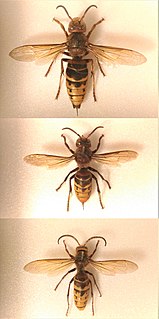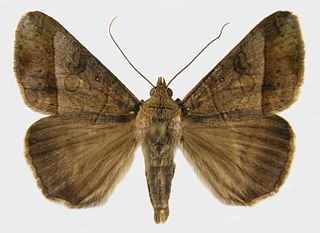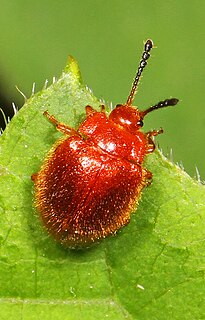
Hornets are the largest of the eusocial wasps, and are similar in appearance to their close relatives yellowjackets. Some species can reach up to 5.5 cm (2.2 in) in length. They are distinguished from other vespine wasps by the relatively large top margin of the head and by the rounded segment of the abdomen just behind the waist. Worldwide, 22 species of Vespa are recognized. Most species only occur in the tropics of Asia, though the European hornet, is widely distributed throughout Europe, Russia, North America, and Northeast Asia. Wasps native to North America in the genus Dolichovespula are commonly referred to as hornets, but are actually yellowjackets.

The European hornet is the largest eusocial wasp native to Europe. It is also the only true hornet found in North America, having been introduced by European settlers in the 1800s. V. crabro is usually regarded as a pest by those humans who come into contact with it. Vespines, like V. crabro, are known for making intricate paper-like nests out of surrounding plant materials and other fibers. Unlike most other vespines, reproductive suppression involves worker policing instead of queen pheromone control, as was previously thought.

The Japanese rice fish also known as the medaka, is a member of genus Oryzias (ricefish), the only genus in the subfamily Oryziinae. This small native of East Asia is a denizen of rice paddies, marshes, ponds, slow-moving streams and tide pools. It is euryhaline, occurring in both brackish and freshwater. It became popular as an aquarium fish because of its hardiness and pleasant coloration: its coloration varies from creamy-white to yellowish in the wild to white, creamy-yellow, or orange in aquarium-bred individuals. Bright yellow, red or green transgenic populations, similar to GloFish, have also been developed, but are banned from sale in the EU. The medaka has been a popular pet since the 17th century in Japan. After fertilization, the female carries her eggs attached anterior to the anal fin for a period before depositing them on plants or similar things.
Tipra latipes is the only species in the monotypic moth genus Tipra of the family Erebidae. It is found in Guiana. Both the genus and species were first described by Francis Walker in 1869.
Schistura crabro is a species of ray-finned fish in the stone loach genus Schistura from Laos.
Citrus latipes, commonly called "Khasi papeda", is sometimes mistakenly identified as Kaffir lime. Native to Northeast India, the khasi papeda is a small, thorny tree that closely resembles both kaffir limes and ichang papedas. Though rarely eaten, and extremely rare in cultivation, the fruit is edible.

Mocis latipes, the small mocis moth or striped grass looper, is a species of moth of the family Erebidae. It is found from North America (from southern Ontario and Quebec to Florida, west to Arizona, north to Minnesota and south through Central to South America.

Crabro is a genus of square-headed wasps belonging to the family Crabronidae. There are at least 80 described species in Crabro, found in the Nearctic and Palaearctic (Holarctic).
Crabro villosus is a species in the order Hymenoptera, in the class Insecta ("insects"). It is found in North America.
Crabro cingulatus is a species of square-headed wasp in the family Crabronidae. It is found in Central America and North America.
Crabro tumidus is a species of square-headed wasp in the family Crabronidae. It is found in North America.

Rhinoncomimus latipes, the mile-a-minute weevil, is a species of minute weevil in the family of beetles known as Curculionidae. Originally from Asia, it has been intentionally introduced in North America to control the invasive Asian weed, mile-a-minute which is its food plant.

Anthidiellum is a genus of rotund resin bees in the family Megachilidae. There are more than 60 described species in Anthidiellum.
Crabro argusinus is a species of square-headed wasp in the family Crabronidae. It is found in North America.

Stenotarsus is a genus of handsome fungus beetles in the family Endomychidae. There are more than 50 described species in Stenotarsus.
Crabro snowii is a species of square-headed wasp in the family Crabronidae. It is found in North America.
Leptometopa latipes is a species of freeloader flies in the family Milichiidae.
Leptometopa is a genus of freeloader flies in the family Milichiidae. There are about 19 described species in Leptometopa.
Protopiophila latipes is a species of cheese skippers, insects in the family Piophilidae.
Tracheliodes is a genus of wasps belonging to the family Crabronidae.








